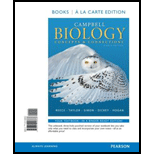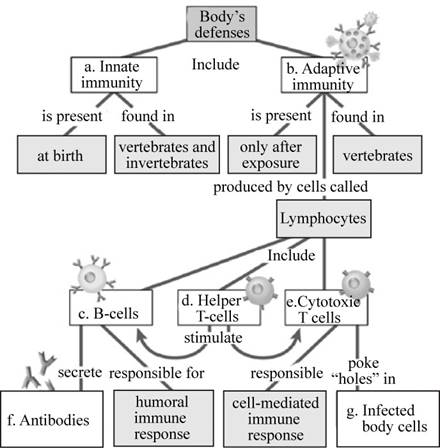
Concept explainers
Complete this concept map to summarize the key concepts concerning the body’s defenses.

To complete: The given concept map and to summarize the key concepts concerning body’s defense.
Introduction:
The immune system of the human body is divided into two main branches, namely the innate immunity and the adaptive immunity. Innate or the body’s first defense mechanism is present since birth and this defense mechanism are non-specific, which means it acts as a barrier in for every foreign body irrespective of its structure. Adaptive immunity of the body comes in later stages, when the body is introduced to pathogens. It is a specific type of defense mechanism.
Answer to Problem 1CC
Pictorial representation: A concept map explaining immune defense mechanisms of body is presented in Fig.1.

Fig. 1: Map depicting the concept of body’s defenses
Explanation of Solution
a)
Correct answer: Innate immunity.
Explanation:
Innate immunity is the immunity present in the body since birththat helps in protecting the body from infection. Hence the correct answer is innate immunity.
(b)
Correct answer: Adaptive immunity.
Explanation:
Adaptive immunity is the immunity that is acquired by the body when the body comes in contact with the foreign agent. Hence the correct answer is adaptive immunity.
(c)
Correct answer: B-cells.
Explanation:
B-cells are the immune cells that help in the protecting the body from infection and is a part of the humoral immunity. Hence the correct answer is B-cells.
(d)
Correct answer: Helper T-cells.
Explanation:
Helper T-cells helps in the recognizing the foreign antigen and instigate the release of antibodies. Hence the correct answer is helper T-cells
(e)
Correct answer: Cytotoxic T cells.
Explanation:
Cytotoxic T-cells help in neutralizing the antigen carrying cell by attaching to it and releasing degenerative enzymes. Hence the correct answer is cytotoxic T cells.
(f)
Correct answer: Antibodies.
Explanation:
Antibodies are protein molecules that help in the recognizing foreign antigen and eliciting an immune response. Hence the correct answer is antibodies.
(g)
Correct answer: Infected body cells.
Explanation:
Infected body cells are the host’s cells that are penetrated by the infectious agent. Hence the correct answer is infected body cells.
Want to see more full solutions like this?
Chapter 24 Solutions
Campbell Biology: Concepts & Connections, Books a la Carte Plus Mastering Biology with eText -- Access Card Package (8th Edition)
- It is often helpful to draw a complicated pathway in the form of a flow chart to visualize the multiple steps and the ways in which the steps are connected to each other. Draw the antibody-mediated immune response pathway that acts in response to an invading virus.arrow_forwardCompare and contrast CD4 and CD8 T cells. Include in your response references to structure, activation, and effector function.arrow_forwardThe defenses created by physical barriers are often supported by chemical barriers (and vis versa), in the innate immune response, as a way to target the normal living conditions of foreign invaders. This may include an acidic environment, a nutrient deprived environment, or sequestering/ blocking an organism into a certain location in the body. True Falsearrow_forward
- Based on your understanding of the innate immune system list 3 broad categories (and AT LEAST ONE specific example in each category) that constitute the first line of defense mechanisms by the innate immune system. (Give an approximate time line for this type of defense) If this defense system is breached describe the process that follows (second line of innate defense). Explain how pathogens are detected and dealt with at this time with specific pathogen groups in mind, innate immune cells and molecular components involved. (Give an approximate timeline for this response) What are the TWO possible outcomes of this response and the way forward?arrow_forwardMatch the following principles to its respective concepts. Match each item to a choice: Innate Immune System Immune System Adaptive Immune System Choices: : Physiological System for Infection Control : Protective Barriers for Infection : Prolonged Protection for Infectionarrow_forwardThe immune system can be split into two major categories, the innate immune system and the adaptive immune system. Compare and contrast these two systems and their response to a bacterial pathogen that entered the body through a cut in the skin. In your answer describe two ways in which the innate immune system protects against this pathogen, as well as two ways that the adaptive immune system protectS against this pathogen. Be sure to name any cells/organs/tissues/structures that may be involved in each of these processes in order to receive full marks. This can be done as a list in point form.arrow_forward
- Imagine a new viral infection has emerged in the southwestern U.S. The virus has distinct surface properties such that prior infections with other viruses is not providing immunity against this virus and it starts to spread rapidly. Diagram and/or describe the major steps of immune response to infection by this virus. Include both the innate and adaptive immune responses. How do antibodies help block viral infection? Once the virus enters a cell it is no longer accessible to antibodies or immune cells. What type of T cells are most important for this stage of infection? How do these T cells recognize infected cells and stop the infection?arrow_forwardBriefly compare and contrast B cells and T cells with respect to their formation, structure, and roles in the immune responsearrow_forwardCytokines and chemokines are major inflammatory mediators. Using examples explain their principal sources and effects.arrow_forward
- Compare and contrast tissues, cells, molecules and secretions of the Innate Defenses with those ofAcquired Immunity in the human immune system.arrow_forwardExplain why each choice (a-d) is correct or incorrect. All but one of the following occurs during the inflammatory response. Select the example below that does NOT describe the process of inflammation. a. Inflammation increases capillary permeability. b. Chemotaxis draws leucocytes to the site of injury. c. Vasoconstriction prevents excessive blood loss due to injury. d. Release of prostaglandins results in pain.arrow_forwardThe classic inflammatory response (heat, swelling, redness, pain) reflects the communication of innate and adaptive defenses. Which of the following is not correct about this response? Group of answer choices Non-cytopathic viruses stimulate the inflammatory response Adjuvants stimulate inflammation and therefore a good antibody response Dendritic cells link the innate and adaptive responses Tumor necrosis factor alpha is a major inducer of inflammation Increased blood flow is one result of inflammationarrow_forward
 Human Heredity: Principles and Issues (MindTap Co...BiologyISBN:9781305251052Author:Michael CummingsPublisher:Cengage Learning
Human Heredity: Principles and Issues (MindTap Co...BiologyISBN:9781305251052Author:Michael CummingsPublisher:Cengage Learning Human Physiology: From Cells to Systems (MindTap ...BiologyISBN:9781285866932Author:Lauralee SherwoodPublisher:Cengage Learning
Human Physiology: From Cells to Systems (MindTap ...BiologyISBN:9781285866932Author:Lauralee SherwoodPublisher:Cengage Learning

